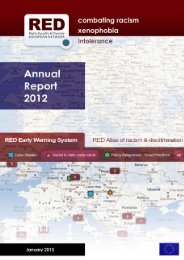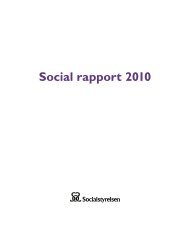R16PITFALLS AND BIAS<strong>the</strong> child (Ryan 1976; Glennon 1995; Ladson-Billings 1998; Linton 1998; Lynch 2001). The Soviet concept <strong>of</strong> defectologywas (<strong>and</strong> to some extent remains in <strong>the</strong> region) <strong>the</strong> “dominant medical approach to categorization, assessment<strong>and</strong> intervention” (Lynch 2001, 17). This current model depends on a diagnosis in order to qualify for an intervention,treating a problem after it develops, instead <strong>of</strong> responding to emerging needs that could alleviate <strong>the</strong> need formore intensive interventions <strong>and</strong> services after identification (Moore 2008, 6). In <strong>the</strong> case <strong>of</strong> children from <strong>Romani</strong>communities, a diagnosis <strong>of</strong>ten serves to segregate children <strong>and</strong> provide <strong>the</strong>m with an inferior education under<strong>the</strong> law. <strong>Romani</strong> children are usually streamed into special education in <strong>the</strong> earliest years, through a regime<strong>of</strong> school readiness testing <strong>and</strong>/or psychological <strong>and</strong>/or educational testing in which children are diagnosed <strong>and</strong>labeled as disabled <strong>and</strong> placed in special education settings, which are usually also segregated.In <strong>the</strong> contemporary historical context, children from <strong>Romani</strong> communities in Central <strong>and</strong> South Eastern Europe,as well as children from ethnic minority communities in almost every country, are affected by “policies thatpurge” (Fine 1991, 81) based on differences that matter. Minow (1990, 51) asserts that:we typically adopt an unstated point <strong>of</strong> reference when assessing o<strong>the</strong>rs. It is from <strong>the</strong> point <strong>of</strong> reference<strong>of</strong> this norm that we determine who is different <strong>and</strong> who is normal…. Unstated points <strong>of</strong> reference mayexpress <strong>the</strong> experience <strong>of</strong> a majority or may express <strong>the</strong> perspective <strong>of</strong> those who have greater access to<strong>the</strong> power used in naming <strong>and</strong> assessing o<strong>the</strong>rs.This construction <strong>of</strong> members <strong>of</strong> <strong>Romani</strong> communities as possessing a difference that matters is in large partbased on <strong>the</strong> “conferred dominance” <strong>of</strong> whiteness (McIntosh, 1990, 35). As such, <strong>Romani</strong> people are displacedoutside <strong>of</strong> <strong>the</strong> “norm” <strong>of</strong> society. Citizens from <strong>Romani</strong> communities possess <strong>the</strong> most visible “difference” <strong>of</strong> manyethnic minorities—<strong>the</strong> color <strong>of</strong> <strong>the</strong>ir skin. It is this visible difference, which should not matter but does, thatlargely contributes to expectations around student performance in schools.Children who are disabled by schools, whe<strong>the</strong>r st<strong>and</strong>ard or special, have experiences in educational milieus in whichteachers have lowered expectations <strong>of</strong> <strong>the</strong>m, presume <strong>the</strong>m to be academically <strong>and</strong> socially deficient, whichleads to fewer teacher interactions with <strong>the</strong>se pupils in <strong>the</strong> classroom; pupils are placed in <strong>the</strong> back <strong>of</strong> classrooms<strong>and</strong> are called on less, have fewer opportunities to engage in meaningful, relevant, <strong>and</strong> challenging classroomtasks, <strong>and</strong> teachers <strong>the</strong>n blame <strong>the</strong>m for <strong>the</strong>ir failure to succeed in schools (Rist, 1978; Oakes 1985; Artiles <strong>and</strong>Trent 1994; Good <strong>and</strong> Brophy 1994; Grossman 1995; Anyon 1997; Artiles 1998; Gay 2001; Solorozano <strong>and</strong> Yosso2001; Gay 2002). Artiles (1998, 32) asserts that teachers have assumptions about difference made about minoritypupils. These assumptions lead to biased expectations <strong>of</strong> minority pupils that in turn lead to biased treatment<strong>of</strong> pupils; <strong>the</strong>se biased, negative expectations <strong>of</strong> pupils generate cycles <strong>of</strong> self-fulfilling prophecies, wherebymarginalized pupils continue to be marginalized, are not provided equality <strong>of</strong> educational opportunity, <strong>and</strong> thusperform poorly (Grossman, 1995, 66; Gay, 2002, 615).
R17This disabling is particularly evident in <strong>the</strong> case <strong>of</strong> children from <strong>Romani</strong> communities. The failure <strong>of</strong> schools limitsopportunities for secondary education, in turn negatively affecting participation in <strong>the</strong> labor market <strong>and</strong>impacting <strong>the</strong>ir poverty status. The overall result is thus ossification <strong>of</strong> a cycle <strong>of</strong> special education, school failure,unemployment, <strong>and</strong> poverty.REGIONAL TRENDS IN SPECIAL EDUCATION ENROLMENT RATESThe countries that do not categorize special educational needs in legislation — Finl<strong>and</strong>, France, Italy, <strong>and</strong> <strong>the</strong> UnitedKingdom — have <strong>the</strong> lowest rates <strong>of</strong> segregating children in special schools. Italy has <strong>the</strong> lowest rate <strong>of</strong> segregation,with 693 pupils total out <strong>of</strong> a special educational needs population <strong>of</strong> 170,696. The United Kingdom <strong>and</strong> Italyhave remained <strong>the</strong> most consistent with low segregation rates in <strong>the</strong> years between 2001 <strong>and</strong> 2008, at less than0.5 percent <strong>and</strong> 1.1 percent respectively. Both France <strong>and</strong> Finl<strong>and</strong>’s rates <strong>of</strong> segregation in special schools havedecreased in <strong>the</strong>se years, as has <strong>the</strong> percentage <strong>of</strong> children diagnosed with special educational needs.The Czech Republic’s percentage <strong>of</strong> children with special educational needs has dropped, from 9.8 percent to 8.6percent, as has <strong>the</strong> percentage <strong>of</strong> pupils segregated in special schools, from five percent to 3.5 percent. However,this is still well above <strong>the</strong> two percent average found in Europe (Meijer, Soriano, <strong>and</strong> Watkins 2003, 11). The rate<strong>of</strong> identification <strong>of</strong> children with special needs has increased in Hungary <strong>and</strong> <strong>the</strong> Slovak Republic, from 4.1 percentto 5.8 percent in Hungary <strong>and</strong> from 4.0 percent to 7.7 percent in <strong>the</strong> Slovak Republic. The rate <strong>of</strong> segregation inspecial schools is somewhat stable in <strong>the</strong> Slovak Republic, 3.4 percent in 2001 <strong>and</strong> 3.6 percent in 2008, while <strong>the</strong>rate has slightly dropped in Hungary, from 3.7 percent to 2.9 percent.TABLE 1. Placement <strong>of</strong> students with special educational needs relative to total student populationTotal number Percent SEN Percent in Percent in Percent fully<strong>of</strong> pupils special schools special classes included2001* 2008** 2001* 2008** 2001* 2008** 2001* 2008** 2001* 2008**CZ 1,146,607 888,000 9.8 8.6 5.0 3.5 – 1.0 – 4.1FI 583,945 556,470 17.8 8.0 3.7 1.3 – 2.6 – 4.1FR 9,709,000 12,638,100 3.1 2.7 2.6 0.61 – 1.3 – 0.8HU 1,191,750 1,323,511 4.1 5.8 3.7 2.9 – No data – 2.9IT 8,867,824 7,326,567 1.5 2.3 99.9SK† 762,111 740,654 4.0 7.7 3.4 3.6 – 1.4 – 2.7UK 9,994,159 8,064,696 3.2 2.8 1.1 1.1 – 0.02 – 1.4* SO<strong>UR</strong>CE: Meijer, Soriano, <strong>and</strong> Watkins (2003).** SO<strong>UR</strong>CE: Watkins (2008).† 2001 Data from Watkins (2008); 2008 data from Eurydice (2009a).
- Page 3 and 4: R3CONTENTSACKNOWLEDGMENTS 4EXECUTIV
- Page 5 and 6: R5EXECUTIVE SUMMARYThis policy pape
- Page 7: R7For Romani children in Central an
- Page 10 and 11: R10PITFALLS AND BIAS4. Discontinue
- Page 12 and 13: R12PITFALLS AND BIASINTRODUCTIONThe
- Page 14 and 15: R14PITFALLS AND BIASa child is read
- Page 18 and 19: R18PITFALLS AND BIASTABLE 2. Placem
- Page 20 and 21: R20PITFALLS AND BIASAMONG THE ROOTS
- Page 22 and 23: R22PITFALLS AND BIASTAXONOMY OF “
- Page 24 and 25: R24PITFALLS AND BIASdevelop the ver
- Page 26 and 27: R26PITFALLS AND BIAS2008, 136). Ard
- Page 28 and 29: R28PITFALLS AND BIASBias in test ad
- Page 30 and 31: R30PITFALLS AND BIASWhile the test
- Page 32 and 33: R32PITFALLS AND BIASOF ROMANI CHILD
- Page 34 and 35: R34PITFALLS AND BIAStwo distinct ty
- Page 36 and 37: R36PITFALLS AND BIASPOLICY AND PRAC
- Page 38 and 39: R38PITFALLS AND BIASand had to repe
- Page 40 and 41: R40PITFALLS AND BIASOrientation Tes
- Page 42 and 43: R42PITFALLS AND BIASTABLE 5. Educat
- Page 44 and 45: R44PITFALLS AND BIASCOUNTRY-SPECIFI
- Page 46 and 47: R46PITFALLS AND BIASPLACEMENT IN SP
- Page 48 and 49: R48PITFALLS AND BIASCompulsory scho
- Page 50 and 51: R50PITFALLS AND BIASand Educational
- Page 52 and 53: R52PITFALLS AND BIAS121.1.cc.ii). A
- Page 54 and 55: R54PITFALLS AND BIASTest of School
- Page 56 and 57: R56PITFALLS AND BIASof the overall
- Page 58 and 59: R58PITFALLS AND BIASAS WITH OTHER C
- Page 60 and 61: R60PITFALLS AND BIASfirst grade, or
- Page 62 and 63: R62PITFALLS AND BIASbases listed in
- Page 64 and 65: R64PITFALLS AND BIASof Societies in
- Page 66 and 67:
R66PITFALLS AND BIASTABLE 13. Pupil
- Page 68 and 69:
R68PITFALLS AND BIASROMANI CHILDREN
- Page 70 and 71:
R70PITFALLS AND BIASdetermined to c
- Page 72 and 73:
R72PITFALLS AND BIASdeveloped in th
- Page 74 and 75:
R74PITFALLS AND BIASWechsler Intell
- Page 76 and 77:
R76PITFALLS AND BIAStheir chances t
- Page 78 and 79:
R78PITFALLS AND BIASREPRESENTATION
- Page 80 and 81:
R80PITFALLS AND BIASTABLE 20.Enroll
- Page 82 and 83:
R82PITFALLS AND BIAS
- Page 84 and 85:
R84PITFALLS AND BIASGOOD PRACTICE A
- Page 86 and 87:
R86PITFALLS AND BIASStudent assessm
- Page 88 and 89:
R88PITFALLS AND BIASThe United King
- Page 90 and 91:
R90PITFALLS AND BIASor assistance i
- Page 92 and 93:
R92PITFALLS AND BIASTeachers report
- Page 94 and 95:
R94PITFALLS AND BIASTHE DETERMINATI
- Page 96 and 97:
R96PITFALLS AND BIASintellectual di
- Page 98 and 99:
R98PITFALLS AND BIAS8. Ensure that
- Page 100 and 101:
R100PITFALLS AND BIASANNEX 1:RELIAB
- Page 102 and 103:
R102PITFALLS AND BIAS1. Does the te
- Page 104 and 105:
R104PITFALLS AND BIASANNEX 2:COMPON
- Page 106 and 107:
R106PITFALLS AND BIASFIGURE A4. Sam
- Page 108 and 109:
R108PITFALLS AND BIASAshton-Warner,
- Page 110 and 111:
R110PITFALLS AND BIASCahn, Claude,
- Page 112 and 113:
R112PITFALLS AND BIASD.H. and Other
- Page 114 and 115:
R114PITFALLS AND BIASFigueroa, Rich
- Page 116 and 117:
R116PITFALLS AND BIASGovernment of
- Page 118 and 119:
R118PITFALLS AND BIASHayman, Robert
- Page 120 and 121:
R120PITFALLS AND BIASKovács-Cerovi
- Page 122 and 123:
R122PITFALLS AND BIASMacura-Milovan
- Page 124 and 125:
R124PITFALLS AND BIASMoore, Tom. 20
- Page 126 and 127:
R126PITFALLS AND BIASRadivojevic, D
- Page 128 and 129:
R128PITFALLS AND BIASShepard, Lorri
- Page 130 and 131:
R130PITFALLS AND BIASTomatová, Jan
- Page 132 and 133:
R132PITFALLS AND BIASVláda Česká
- Page 134:
Copyright © 2012 Roma Education Fu




